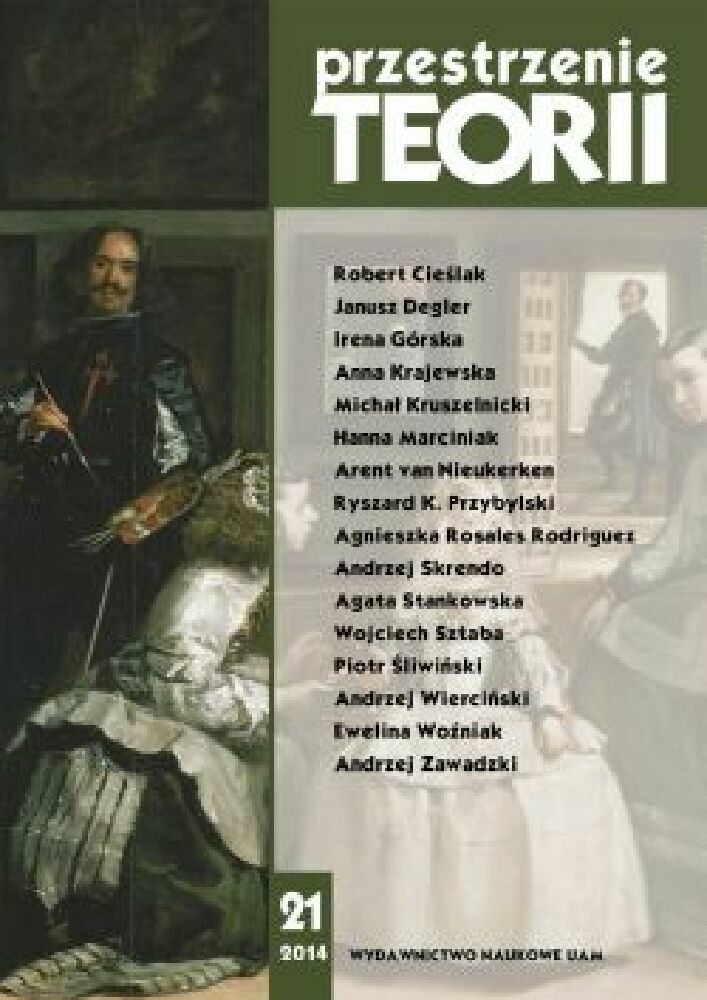Abstrakt
his article attempts to analyze Tadeusz Różewicz’s works by using methods that are associated with performative literary studies. The author refers to concepts of quantum physics and introduces a new aesthetic category, “entangled arts”. Among these arts are, for example, drama and theater, which are seen from an anti-binary perspective. This approach eliminates the traditional division of arts into the art of literature and performing arts, thus leading us to look on literature as a performing art. Therefore, the idea of “entangled arts” is not about “the synthesis of arts”, but about their unresolvedness and an act of reading which requires one to simultaneously exist and be active in two different realities, for example, in a digital and imagined world, or in film and on stage. Różewicz adheres to the same principle as Diego Velázquez when he was painting Las Meninas, which represents a trap of a performative painting. This is true of Kartoteka rozrzucona [The Scattered Card Index], Pułapka [The Trap] and the short story Grzech [The Sin]. The author of this article considers Tadeusz Różewicz to be the greatest modern writer, a dramatic poet who pushes the boundaries of art, and an artist who is both present and absent.Bibliografia
J. Hillis Miller, O literaturze, przeł. K. Hoffmann, Poznań 2014, s. 40.
A. Krajewska, Splątanie literackie, „Przestrzenie Teorii” 2012, nr 17, s. 8.
W. Faulstich, R. Strobel, „«Uksiążkowienie» jako problem estetyczno-medialny. Obcy – ósmy pasażer Nostromo – studium przypadku”, przeł. M. Kasprzyk, przekład przejrzał K. Kozłowski, „Przestrzenie Teorii” 2014, nr 22.
M. Leyko, Teatr w przestrzeni historii, „Dialog” 2013, nr 4, s. 5.
P. Nora, Czas pamięci, przeł. W. Dłuski, „Res Publica Nowa” 2001, nr 7.
A.C. Danto, Po końcu sztuki. Sztuka współczesna i zatarcie się granic tradycji, przeł. M. Salwa, Kraków 2013.
Wykład Georges’a Didi-Hubermana „Miejsca mimo siebie” poświęcony sztuce MirosławaBałki, 16 czerwca 2011, Muzeum Sztuki Nowoczesnej w Warszawie. Tekst wykładu
na podstawie nagrania zamieszczonego w internecie na stronie Muzeum Sztuki Nowoczesnejw Warszawie .
R. Eshelman, Performatyzm albo koniec postmodernizmu („American Beauty”), przeł. K. Hoffmann, „Przestrzenie Teorii” 2012, nr 17.
T. Różewicz, to i owo, opracowanie, redakcja i posłowie J. Stolarczyk, Wrocław 2012.
W.B. Worthen, Między literaturą a przedstawieniem, przeł. M. Sugiera, M. Borowski,Kraków 2014, s. 319-340.
J. Culler, Literatura w teorii, przeł. M. Maryl, Kraków 2013, s. 190-192.
J. Snyder, „Las Meninas” i „zwierciadło księcia”, [w:] Tajemnica „Las Meninas”, antologia tekstów, wybór i redakcja A. Witko, Kraków 2006, s. 179.
D.Taylor, The Archive and the Repertoire. Performing Cultural Memory in the Americas, Duke University Press, Durham–London 2003.
T. Różewicz, Grzech, [w:] tenże, Matka odchodzi, Wrocław 2000.
G. Didi-Huberman, Przed obrazem, przeł. B. Brzezicka, Gdańsk 2011.
A. Krajewska, Dyskurs dramatyczny w twórczości Tadeusza Różewicza, [w:] Przekraczanie granic. O twórczości Tadeusza Różewicza, red. W. Browarny, J. Orska, A. Poprawa, Kraków 2007.
T. Różewicz, Poemat autystyczny, [w:] tenże, zawsze fragment, Wrocław 1996, s. 80.
T. Różewicz, ***, [w:] tenże, zawsze fragment. recycling, Wrocław 1998, s. 54.
Licencja
Autorzy
Autorzy tekstów przyjętych do publikacji w czasopiśmie „Przestrzeniach Teorii” są zobowiązani do wypełnienia, podpisania i odesłania na adres redakcji umowy o udzielenie nieodpłatnej licencji do utworów, z zobowiązaniem do udzielania sublicencji CC.
Zgodnie z umową, autorzy tekstów opublikowanych w czasopiśmie „Przestrzeniach Teorii” udzielają Uniwersytetowi im. Adama Mickiewicza w Poznaniu niewyłącznej i nieodpłatnej licencji oraz zezwalą na użycie sublicencji Creative Commons Attribution-NonCommercial-NoDerivatives 4.0 International (CC BY-NC-ND 4.0).
Autorzy zachowują prawa do dalszego, swobodnego rozporządzania utworem.
Autorzy, którzy wykorzystują w swoim tekście cudze utwory (np. ilustracje, fotografie) proszeni są o dostarczenie do redakcji czasopisma zgodę na publikację od uprawnionych podmiotów.
Użytkownicy
Zainteresowani użytkownicy internetu uprawnieni są do korzystania z utworów opublikowanych po 2015 roku „Przestrzeniach Teorii” tylko w calach niekomercyjnych, pod następującymi warunkami:
- uznanie autorstwa - obowiązek podania wraz z rozpowszechnionym utworem, informacji, o autorstwie, tytule, źródle (odnośniki do oryginalnego utworu, DOI) oraz samej licencji;
- bez tworzenia utworów zależnych - utwór musi być zachowany w oryginalnej postaci, nie można bez zgody twórcy rozpowszechniać np. tłumaczeń, opracowań.
Do wszystkich tekstów opublikowanych przed 2015 r. prawa autorskie są zastrzeżone.
Inne
Uniwersytet im. Adama Mickiewicza w Poznaniu zachowuje prawo do czasopisma jako całości (układ, forma graficzna, tytuł, projekt okładki, logo itp.).
